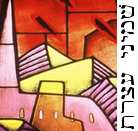|
Observance of Shemini Atzeret
In Israel, Shemini Atzeret and Simchat Torah are both celebrated on Tishri 22, but in the Diaspora (communities outside of Israel), Shemini Atzeret is observed on Tishri 22 and Simchat Torah on Tishri 23.
In the Diaspora, Shemini Atzeret is considered a full holiday (Yom Tov), but none of the particular mitzvot regarding Sukkot are observed (though some Jews still eat in their sukkah while others do not [as described in the Talmud, Sukkah 46b, 47a]. However, since it is a separate holiday, the usual rituals such as candle lighting, saying kiddush, refraining from work, attending special synagogue services, etc., are practiced.
Tefillat Geshem (ū¬ų╝ų░ūżų┤ū£ų╝ųĘū¬ ūÆųČū®ūüųČūØ)
Shemini Atzeret is perhaps best known for the tefillat geshem, or "the prayer for rain," recited during the Musaf service (an additional prayer service recited right after the morning service). The prayer for rain is inserted in the second section of the Amidah (or Shmoneh Esrei) where the phrase "Mashiv HaRuach U'Morid HaGeshem" [who makes the wind blow and makes the rain descend] is added to the blessing. This addition to the wording of the Amidah is hereafter recited until Pesach.
But why formalize a prayer for rain?
In Israel, crops planted in the spring (aviv) depend on the rainfall that occurs in the fall (tsav). Moreover, according to Jewish tradition, all the world is judged at this time regarding the amount of rainfall to be given for the coming year. Therefore, beginning with Shemini Atzeret additional prayers for rain are made part of the synagogue service through the addition to the Amidah.
Spiritual Significance of Shemini Atzeret
The word atzeret comes from atzar, meaning to collect or to store. Since Sukkot marks the end of the Fall Festivals, it is suggested that Shemini Atzeret is meant as a time to reflect on the previous two months of observance and to store their memories within our hearts.
In short, the holiday is more inwardly focused, though there are customs that help prepare for the coming day of Simchat Torah during the Ma'ariv [evening] service.
In addition, in Temple times during the week of Sukkot seventy bulls were sacrificed as Musaf offerings on the altar (for the seventy nations of the earth), but on Shemini Atzeret only one bull was sacrificed - for Israel alone:
"You may compare it to a king who had a festival for seven days and invited all the nations of the world to the seven days of feasting. When the seven days were over and the guests had gone, he said to his friend (Israel), 'Let us now have a small meal together, just you and I.'" (Bamidbar Rabbah 21, Sukkah 55b)
Remaining with the LORD: a picture of Eternity
Shemini Atzeret suggests the image of "remaining" or "abiding" (atzeret) an extra "day" with the LORD, beyond the seven days of fullness represented by the seven days of Sukkot. Since Sukkot represents the olam habah and the millennial reign of the Mashiach Yeshua in the soon-coming Kingdom, Shemini Atzeret represents the eternal state of perfection, the Day of the new heavens and new earth (Isaiah 65:17, Revelation 21:1).

Whoever abides in me and I in him, he it is that bears much fruit,
for apart from me you can do nothing.
|



